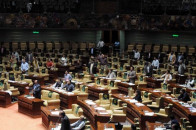Endangered city: Green city becoming a ‘haven of pollution’
Pakistanis from other major cities have often referred to Islamabad as the ‘green graveyard’.

The absence of a proper dumping site, a dilapidated sewage system, unplanned industrial units in residential areas, absence of a public mass-transit system and violations of bylaws by authorities are some of the main reasons for the “green” city’s increasing pollution.
Dumping sites
This is perhaps the only capital city that lacks a proper dumping site and a system of waste recycling. Defying Islamabad High Court orders, the Capital Development Authority did not relocate the dumping site to an area along Kashmir Highway near International Islamic University Islamabad.
Sewage system
The supply of contaminated water from Rawal Lake compelled the Supreme Court to take suo motu action and order the concerned authorities to take concrete steps to ensure clean-water supply to the city’s inhabitants. Unfortunately, the civic authority failed to introduce a better sewage system to the city.
Functioning of industries, brick-kilns and asphalt plant in residential areas
Residential sectors are sandwiched between the industrial zones, posing many serious health risks to citizens. Hundreds of industrial units are currently functional in three different residential areas. Despite Supreme Court orders, no steps to relocate the units from residential areas have been taken so far.
The operation of brick-kilns in Zone-5 could also not be brought to a halt despite the decision taken by the environmental tribunal. The illegal functioning of Frontier Works Organization’s asphalt plant in the heart of the city near Jasmine Garden also raises serious questions over the roles of the CDA and the Pakistan Environmental Protection Agency (Pak-EPA).
Absence of Mass Transit System
The concerned authority has also failed to tackle the growing traffic nuisance in the city by not developing and launching a feasible system of mass transit. The present public transport facilities are “abysmal”, according to various reports. Besides, due to the absence of efficient, affordable and comfortable public transport, the number of motorcycles is steadily increasing on the capital’s roads. Despite the obvious problems, the CDA recently scrapped a planned mass transit project yet again.
Violation of Pak-EPA’s bylaws
Apparently, the CDA has opted for zero compliance with Pak-EPA’s bylaws. The unplanned construction of the Zero Point interchange is a case in point, as hundreds of trees were chopped with total disregard for environmental regulations.
Similarly, haphazard construction in Shakarparian, where construction is prohibited, led to the axing of more than two thousands trees. The CDA’s Cultural Complex has been under construction for many years on hundreds of acres of green land.
Violations of CDA bylaws
The emergence of fake housing societies is on the rise, apparently unchecked by the authorities. Moreover, the concerned authorities have yet to address the plethora of problems related to the functioning of a large number of foreign missions in residential areas.
Proposed amendments in zoning regulations
The move to introduce controversial amendments in zoning regulations to change the status of Zone-3 and Zone-4 indicate another alarming situation. According to Zoning Regulations Rules 1992, any type of construction in the aforesaid zones is strictly prohibited, in order to maintain the city’s greenery.
What Task Force Report 2011 on Urban Development suggests
Predictably, the report’s main recommendation is to run CNG buses in a mass transit system to meet the mobility needs of the public and to reduce the pollution caused by private vehicles. Similarly, the report suggests steps such as, “Creating urban eco-system by following practices such as the promotion of kitchen gardens, reuse and recycling of waste, rain harvesting, protection of gardens, parks, open spaces and green areas.”
The report also reveals the lack of effective application of environmental management techniques, for example, Environmental Impact Assessment (EIA) and National Environment Quality Standards for Soil (NEQSs). Further, deficiencies in the institutional and legal structures, as envisioned under National Environmental Policy 2006, have resulted in cities that are “heavens of pollution”. On the one hand, the polluters don’t pay for the filth they spread, while on the other, public investment tends to support their economic activities than to clean their polluting consequences.
Published in The Express Tribune, February 21st, 2011.



















COMMENTS
Comments are moderated and generally will be posted if they are on-topic and not abusive.
For more information, please see our Comments FAQ